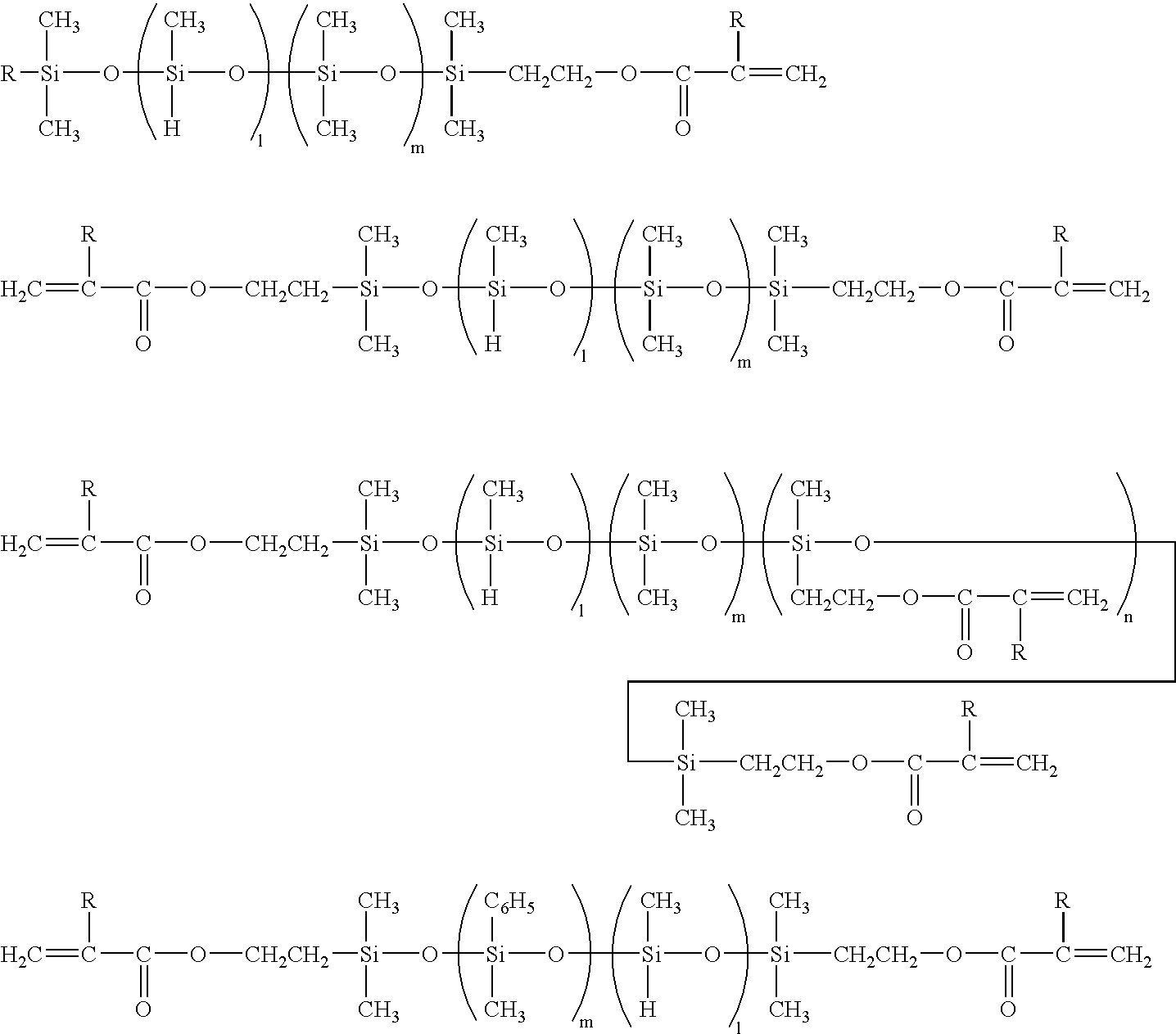Radiation curing silicone rubber composition and adhesive silicone elastomer film
a technology of silicone rubber and composition, applied in the direction of film/foil adhesives, liquid degasification, separation processes, etc., can solve the problems of poor thermal and mechanical stress relaxation properties, inability to convert, and inadequate heat resistance, and achieve uniform film production within a short period of time, good handling effect, and low elasticity
- Summary
- Abstract
- Description
- Claims
- Application Information
AI Technical Summary
Benefits of technology
Problems solved by technology
Method used
Image
Examples
example 1
[0072](B) 100 parts of a (meth)acryloyl group containing organopolysiloxane with a structure shown below, [0073](D) 2 parts of 2-hydroxy-2-methyl-1-phenylpropan-1-one,[0074](C) 3 parts of a partial hydrolysis-condensation product of tetramethoxysilane with a structure shown below, and [0075] (a mixture in which m represents an integer of 1 to 7)[0076](A) 20 parts of an acryloyl group containing methylhydrogenpolysiloxane with a structure shown below were mixed together and yielded a radiation curing silicone rubber composition (with a weight referenced ratio (C) / [(A)+(B)]=2.5 / 100). [0077] (wherein, l=20 and m=80)
[0078]This composition was poured into a Ni plated mold (height 100 mm×width 100 mm×depth 1 mm), and then irradiated with ultraviolet radiation (radiation dose: 800 mJ / cm2) for 2 seconds inside a conveyor furnace equipped with two metal halide mercury lamps (illumination intensity: 400 mW / cm2) to cure the composition. The hardness of the thus obtained adhesive silicone elast...
example 2
[0080]With the exception of using 3 parts of an epoxy group containing polyalkoxysiloxane with a structure shown below instead of the 3 parts of the partial hydrolysis-condensation product of tetramethoxysilane of the constituent (C) above, a composition was prepared in the same manner as the example 1, and this composition was then used to produce an adhesive silicone elastomer film and a series of structural bodies, which were subjected to the same tests as the example 1. The results of the tests are shown in Table 1 and Table 2.
(wherein, n=6)
example 3
[0081]With the exception of using 1 part of a triisocyanurate silicone modified compound with a structure shown below instead of the 3 parts of the partial hydrolysis-condensation product of tetramethoxysilane of the constituent (C) above, a composition was prepared in the same manner as the example 1 (with a weight referenced ratio (C) / [(A)+(B)]=0.8 / 100), and this composition was then used to produce an adhesive silicone elastomer film and a series of structural bodies, which were subjected to the same tests as the example 1. The results of the tests are shown in Table 1 and Table 2.
PUM
| Property | Measurement | Unit |
|---|---|---|
| temperature | aaaaa | aaaaa |
| temperature | aaaaa | aaaaa |
| temperature | aaaaa | aaaaa |
Abstract
Description
Claims
Application Information
 Login to View More
Login to View More - R&D
- Intellectual Property
- Life Sciences
- Materials
- Tech Scout
- Unparalleled Data Quality
- Higher Quality Content
- 60% Fewer Hallucinations
Browse by: Latest US Patents, China's latest patents, Technical Efficacy Thesaurus, Application Domain, Technology Topic, Popular Technical Reports.
© 2025 PatSnap. All rights reserved.Legal|Privacy policy|Modern Slavery Act Transparency Statement|Sitemap|About US| Contact US: help@patsnap.com



